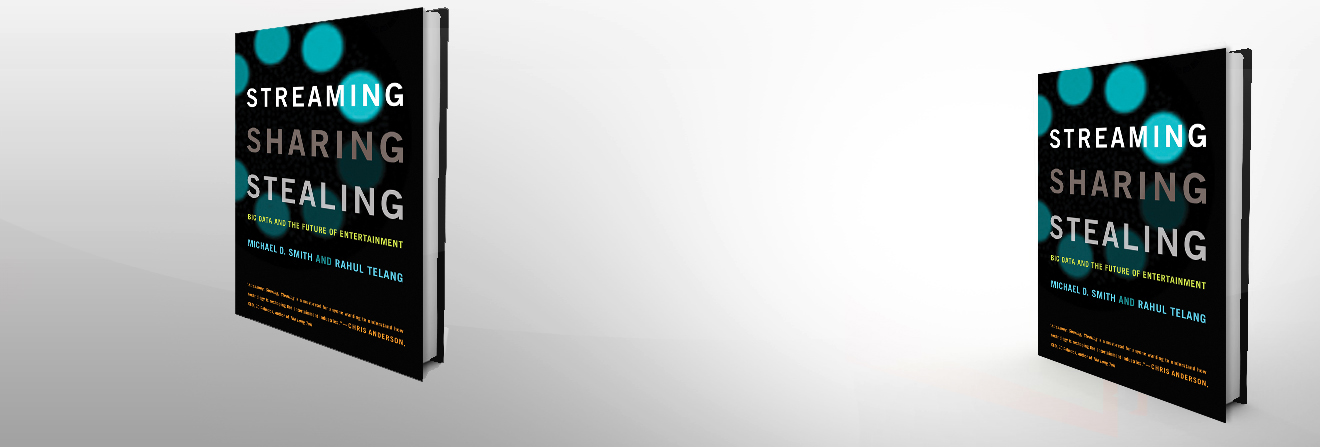Book Review: Streaming, Sharing, Stealing: Big Data and the Future of Entertainment by Michael D. Smith and Rahul Telang
Will publishers, recording labels, and movie studios be able to meet the challenges posed by new technology?
Streaming, Sharing, Stealing: Big Data and the Future of Entertainment (MIT Press 2016) is a book written by Michael D. Smith and Rahul Telang, two professors of Information Systems and Marketing at Carnegie Mellon University’s Heinz College. The authors of Streaming have summarized ten years of their research in a well-written account of how big internet-based intermediary platforms like Amazon, Apple’s iTunes, Spotify and Netflix are giving the creative industries a great deal of competition.
In the 20th century record labels, publishing houses and movies studios managed two forms of scarcity: in the distribution and promotion channels as well as in the financial and technical resources necessary to create content. Business models relied on maintaining control over how consumers were able to obtain music, texts, computer games and films. They also relied on controlling talent and promoting a product streamlined for the delivery channels.
Advances in computers, storage equipment, and the world wide web have made content much more available. The production, distribution and promotion of content have become much simpler, opening up new markets and opportunities for talent that previously would have never been considered by the major labels.
Streaming, Sharing, and stealing covers piracy, but not in such detail as implied by the title. The duo made their fame by conducting reviews of the published academic literature on the impact of piracy on creative artists. They repeat their finding that piracy causes harm to producers by reducing legal sales and diminishing the potential revenues, as paying customers lose their willingness to pay. When revenues are reduced, producers are likely to invest in fewer projects, thus affecting creative artists as some types of content are no longer profitable for producers to make. Piracy does not seem to create enough buzz for new content to match the revenue lost. Shutting down pirate sites does show some results to reduce their attractiveness. Blocking does not have to be perfect to be effective, and making more titles available legally reduces the demand for pirated content.
Who won the copyright wars of the 00’s then? The distribution platforms!
Anti-piracy and pro-market strategies need to take a broader view to leave the proverbial game of whack-a-mole. If it was just a question about piracy, it would be a manageable problem. It is the combination of several trends that amplifies the change.
The content providers are in trouble the pirates seem confined to the darker parts of the internet. Who won the copyright wars of the 00’s then? The distribution platforms! The digital ecosystem is changing in their favor, as digital distributors have access to customer data and skills to analyze it in order to know the customer, rather than just guessing from previous releases, picking winners, scattering ads and crossing fingers. The users finely grained behavioral patterns provide two new scarce resources: global knowledge about their individual needs and the ability to manage their attention on a single platform. As an example of this new data-driven decision-making, Smith and Telang provide the compelling case of how Netflix created the hit series House of Cards following audience data.
The competition from the long tail is not from an obscure back catalog; rather, it is from competitors able to produce long tail products through adapting them to customer tastes in real time. The digital platforms keep user data proprietary, thus gaining control over the terms of how content reaches the end users and how value is monetized.
The book does not address the issue of advertising, but fact is that digital platforms are competing. Facebook through its sheer scale, and Google through targeting ads to users’ high-intent searches.
Smith and Telang advocate a shift. The majors need to develop a stronger tie between their content and brand. They need to centralize data analytics within the company and be able to share data with stake holders. Pricing has to be not only channel-dependent but also time-dependent, which adds significant complexity. Building a competing platform is difficult due to platform lock-in, information bundling and the costs of platform development.
They have a point. Hulu, with all its issues, is an example of how it can be done. Valve Corporation’s Steam is another. An even better example would be Blocket, Sweden’s Craigslist, owned by Schibsted Media Group and thus able to collect huge amounts of data for its various business branches.
The book is enjoyable and confirms some hunches about recent developments. The findings might be controversial, but Smith and Telang back their assertions with hard data, often lacking in the debate. It makes for a good read to understand the outcome of the copyright wars and the future of creative industries.

